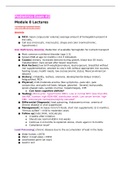Pediatrics Exam #2
Module 8 Lectures
Blood Disorders
Anemia
● MCV: mean corpuscular volume� average amount of hemoglobin present in
the cells.
● Cell size (microcytic, macrocytic), shape and color (normochromic,
hypochromic)
Iron Deficiency Anemia� Reduction of available hemoglobin for nutrient transport
● Most common nutritional disorder (age 1-3).
● Screen HGB at age 12 months (<12 if indicated).
● Causes� dietary, increased demand during growth, blood loss (GI tract),
malabsorption (rare except after bowel resection).
● Risk Factors� low birth weight/premature, lead exposure, breastfed without
iron supplementation, weaned to cow’s milk without appropriate iron sources,
feeding issues, health needs, low socioeconomic status, Mexican-American
descent
● History� irritability, restless, anorexia, developmental delays (motor),
fatigue/tired, PICA
● Physical� mild-moderate anemia (few symptoms—pale skin, pale
conjunctiva, and pale nail beds, fatigue, glossitis). Severe� tachycardia,
spoon-shaped nails, systolic murmur, hepatomegaly, CHF.
o Can have cognitive deficits*
● Testing� Microcystic, hypochromic RBCs. Low or normal MCV (less than 80),
low RBC number, high RDW-RBC distribution width, Low serum ferritin, high
TIBC, reticulocyte normal/low/slightly elevated*
● Differential Diagnosis� lead poisoning, thalassemia minor, anemia of
chronic disease or viral suppression.
● Management� increase iron-rich foods, start iron supplements (2-3 months),
“ferrous sulfate”—mild to moderate cases
● Follow up� labs (H/H), reticulocyte
o 4 weeks after initiation
o Should see normal HGB in 4-6 weeks
o Continue 2-4 months to replenish stores, check again in 6 months
o Compliance issue*
Lead Poisoning� chronic disease due to the accumulation of lead in the body
● Older homes <1978
● Water in lead pipes <1950
● Lead-based paint (on toys)
● Lead in soil
, ● PICA—eating things with no nutritional value (i.e. dirt, ice, chalk, clay, glue).
● **Poor inner city, age 1-3 (highest risk) **
● Toxic is 10mcg/dl or higher (even 5 is considered high in most children)
o Lead level 20mcg/dl single check or 15mcg/dl persistent over 3
months**
▪ Can result in impaired cognitive functioning (7.5 shows
impaired) *
● Differential Diagnosis� iron deficiency thalassemia, metabolic disorders,
developmental delay
● Physical� bluish discoloration of gums, bradycardia, neuropathy,
papilledema, ataxia
● Management� remove from the source, monitor levels, refer for levels 20
and over, 20-44 levels may require medications, levels >45 require chelation
therapy*
Sickle Cell Anemia
● Autosomal recessive (child inherits two hemoglobin’s that sickle)
o Can have the trait (one copy) without the disease
o Both parents being carriers:
▪ AS=sickle cell trait, no disease
▪ AA=normal adult hemoglobin
▪ SS= sickle cell disease*
● RBC have “sickle shape”
● Effects mainly African, Mediterranean, Indian and Middle Eastern
● History� symptoms emerge around 6 months
o Infection (fever, malaise, anorexia, poor feeding)
o Acute painful events (bone pain* most common, but can be anywhere),
swelling, low-grade fever, abdominal pain.
o Eye damage, aseptic necrosis, bone infarcts, leg ulcers
● Splenic Sequestration�Blood gets stuck in spleen* (weakness, irritability,
unusual sleepiness, paleness, large spleen, tachycardia).
● Aplastic Crisis� Decreased hematocrit and reticulocyte count *(pale,
malaise, headache, fever)
● Differentials� septicemia, chronic hemolytic anemia, meningitis,
pneumonia, leukemia, spleen injury
● Diagnostic testing� prenatal—DNA chorionic villus sampling
o newborn screen
o CBC
o HGB electrophoresis* shows dominance of HGB S without A
● Management� pediatric hematologist co-management. Hydration, illness
prevention, and pain management. Penicillin prophylaxis from 2 months to
age 5. Splenectomy (infection with fever 101.5—immediate evaluation).
Genetic counseling, Immunizations, treat infection “biggest risk” *, monitor
labs (CBC, retic) every few months, hydroxyurea with severe cases.
● Emergent: fever, chest pain, unusual headache, visual changes,
priapism*
, Immune or Idiopathic Thrombocytopenic Purpura (ITP)� Circulating platelets
destroyed that usually follows a viral illness.
● Mostly between age 2-4 years, fair-skinned, >6 months=chronic
● History� H/o viral illness within 1-4 weeks preceding, nose bleeds,
menorrhagia, normal CBC except low platelets <150,000*
● Physical� clinical findings usually don’t develop until platelet count
<20,000* Petechiae, purpura, bleeding
● Diagnostics� low platelet count <150,000 (rest of CBC normal), normal
PT/PTT, mega thrombocytes on smear
● Differentials� coagulation factor deficiency, leukemia, meningococcemia,
sepsis
● Management� most managed without treatment.
o Greater <20,000 and no s/s bleeding: avoid contact sports,
aspirin/ibuprofen, or other agents that interfere with platelets.
▪ A complication of low platelet� intracranial hemorrhage <1%
o Platelet level <50,000 can do steroids
o Immunoglobulins (IVIG) for severe bleeding and chronic cases
Hemophilia�coagulation deficiency resulting in prolonged bleeding
● Sex-linked, recessive*
● Affects males* females are carriers
● 85% of male’s hemophilia A, 15% hemophilia B
● Type A (Factor VIII)—most common “classic hemophilia”
o VIII binds with von Willebrand factor
● Type B (Factor IX)
● Presentation� often FH, excessive bleeding/bruising, prolonged aPTT,
prolonged bleeding after circumcision, heme-arthrosis (bleeding into joints).
● Management� Heme referral*Factor replacement, education, complications
(brain hemorrhage, infection due to the factor).
Von Willebrand Disease
● An inherited hemorrhagic disorder characterized by defective primary
hemostasis and due to a quantitative or qualitative abnormality in VWF.
● Different variant types
● Affects both sexes*
● Presentation� mucous membrane bleeding, post-surgical bleeding/post-
traumatic bleeding, heavy periods, nosebleeds, gum bleeding, easy bruising.
● Diagnostics� prolonged bleeding time, absent or decreased VWF
● Treatment� desmopressin acetate (treat bleeding preop).
Leukemias
● Malignant disorders with qualitative and quantitative changes in circulating
leukocytes
● Abnormal precursors in bone marrow “BLASTS” *




